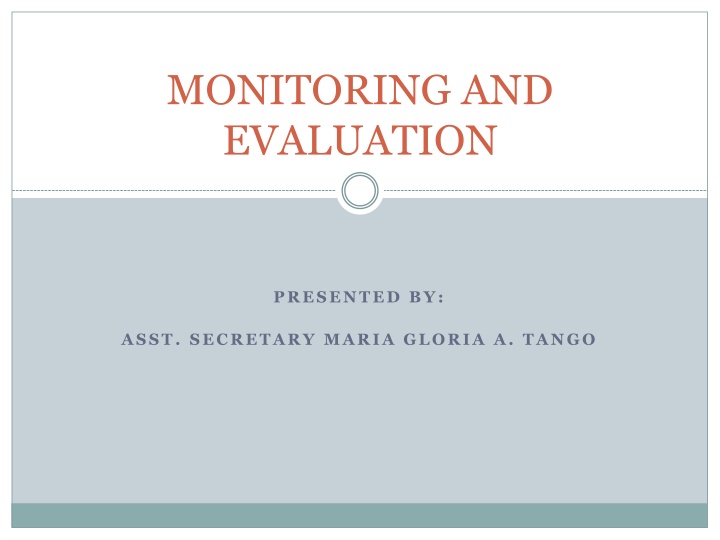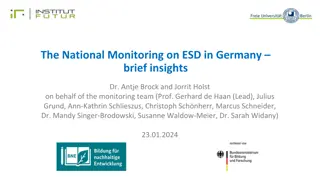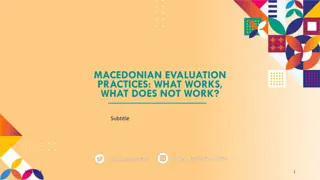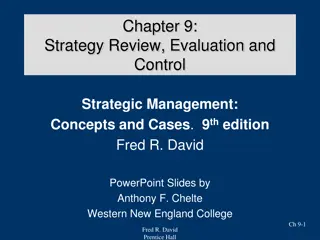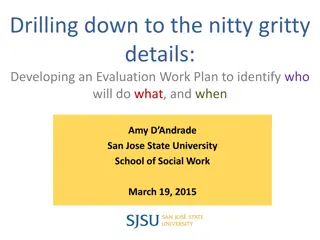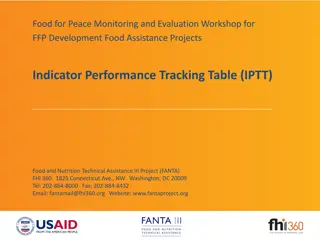Effective Monitoring and Evaluation Practices in Program Management
Asst. Secretary Maria Gloria A. Tango presents on the importance of setting up Monitoring and Evaluation (M&E) systems, showcasing practices, challenges, and opportunities in the M&E process. The presentation highlights the roles of central offices, regional offices, and the Institute of Labor Studies in formulating, implementing, and evaluating programs. It emphasizes the use of tools like the Statistical Performance Reporting System (SPRS) for monitoring project progress, ensuring compliance with guidelines, and assessing impact on beneficiaries. Tracer studies conducted by the Institute of Labor Studies demonstrate the impact of programs like KASAMA, SPES, and EDSP on target beneficiaries.
Download Presentation

Please find below an Image/Link to download the presentation.
The content on the website is provided AS IS for your information and personal use only. It may not be sold, licensed, or shared on other websites without obtaining consent from the author.If you encounter any issues during the download, it is possible that the publisher has removed the file from their server.
You are allowed to download the files provided on this website for personal or commercial use, subject to the condition that they are used lawfully. All files are the property of their respective owners.
The content on the website is provided AS IS for your information and personal use only. It may not be sold, licensed, or shared on other websites without obtaining consent from the author.
E N D
Presentation Transcript
MONITORING AND EVALUATION PRESENTED BY: ASST. SECRETARY MARIA GLORIA A. TANGO
MONITORING AND EVALUATION PRESENTATION OUTLINE 1. Setting up of M & E System 2. Practices in the conduct of M & E 3. Challenges and opportunities
MONITORING AND EVALUATION SETTING UP OF MONITORING AND EVALUATION SYSTEM 1) Central Office a) Program Managers formulate programs and projects - prepares Manual of Operations including M & E system
MONITORING AND EVALUATION 2) Institute of Labor Studies - Research and Development Arm of DOLE - conducts studies relative to labor and employment, including impact evalution of DOLE programs and projects b) Regional Offices - implements programs and projects including monitoring its progress and evaluate its impact to the intended beneficiaries
MONITORING AND EVALUATION PRACTICES IN THE CONDUCT OF MONITORING AND EVALUATION Regional Offices - conduct monthly and quarterly monitoring using Statistical Performance Reporting System (SPRS) - Program focal person monitors the implementation of the individual projects, check whether implementation is in accordance with the approved project proposal (physical and financial) 1)
MONITORING AND EVALUATION - SPRS are forwarded to the Program Managers for consolidation and evaluation - Program managers submit the consolidated SPRS to the Planning Service for submission to top management 2) Program Managers - conducts field monitoring on selected projects in the regional offices to assess ROs compliance to program guidelines, identify problems affecting the implementation; provide feedback to the ROs
MONITORING AND EVALUATION 3) Institute of Labor Studies - conducted several tracer studies to determine the impact of selected DOLE projects to the target beneficiaries - KASAMA livelihood program for parents of child laborers - SPES bridging program to help poor students finish studies - EDSP education program for the benefit of OFWs and their dependents
MONITORING AND EVALUATION CHALLENGES - the importance of baseline data/information to assess the effect and impact of the assistance - availability and capacity of personnel doing the monitoring and evaluation - how to assess the contribution of the program to the lives of the beneficiaries since the intervention is not solely provided by DOLE
